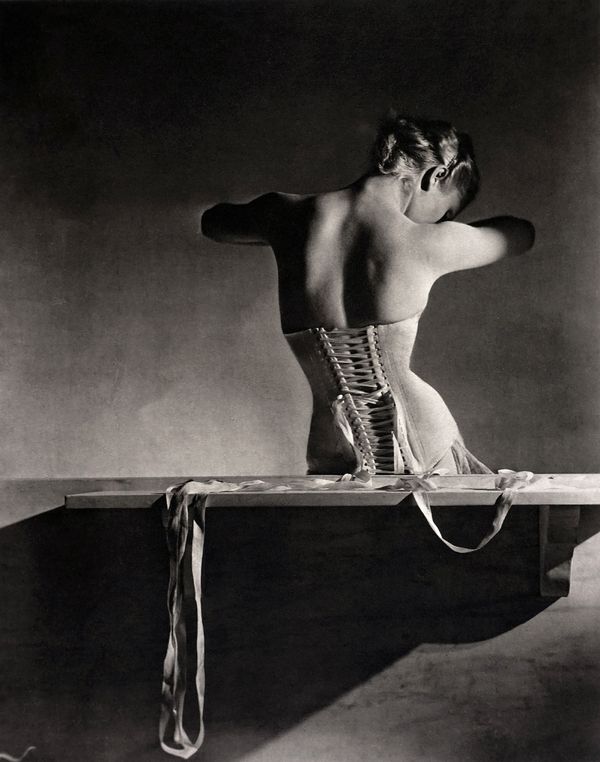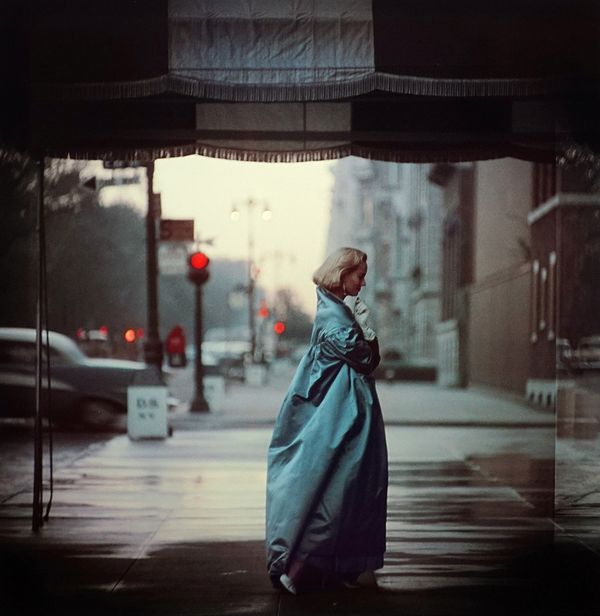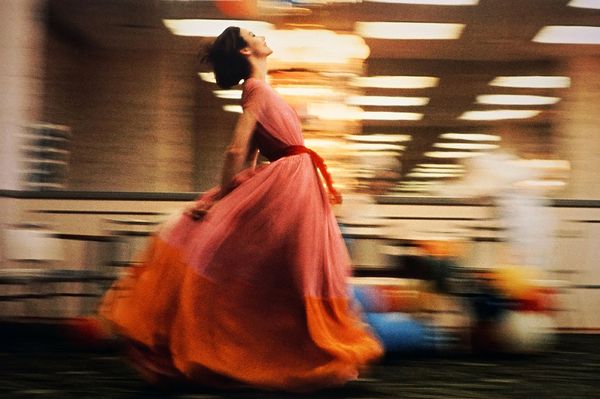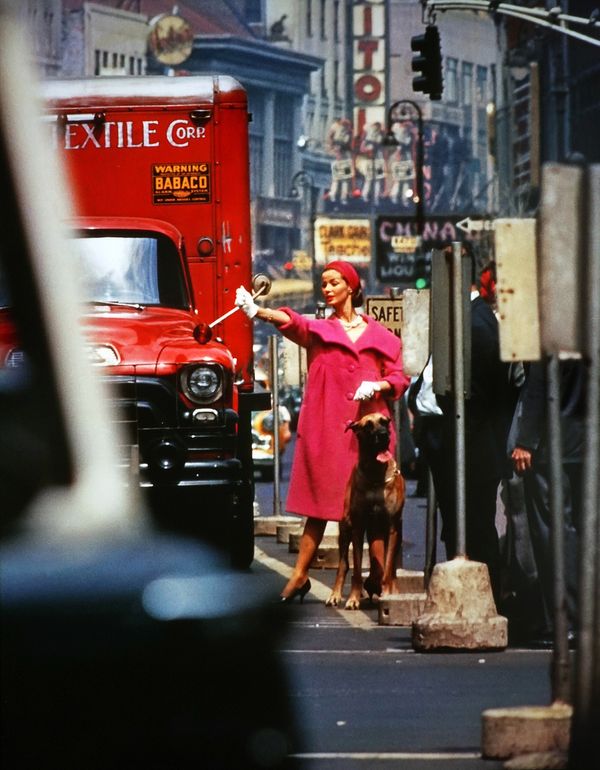Horst P. Horst Mainbocher Corset (Mme. Bernon), Paris, August 11, 1939.
Estimate: $8,000-12,000.
In honor of our online-exclusive auction, Tailor-Made: Fashion Photographs from the Collection of Peter Fetterman, Phillips asked luminaries from the fields of fashion and fashion publishing to give us their view of what makes a truly memorable fashion photograph.
Ivan Shaw is the Corporate Photography Director at Condé Nast. He was the co-author of Around That Time: Horst at Home in Vogue, author of Patti Hansen: A Portrait and recently produced Tonne Goodman: Point of View and Hunks & Heroes: Jim Moore, Four Decades of Fashion at GQ.
Arthur Elgort Wendy Whitelaw on Park Ave., New York City, 1981. Estimate: $5,000-6,000.
“Sometimes it’s what we don’t see in a fashion photograph that makes it so memorable. In both Horst P. Horst’s legendary Mainbocher Corset (Mme. Bernon), Paris, August 11 (Lot 17) and Arthur Elgort’s iconic Wendy Whitelaw on Park Avenue, New York City (Lot 62) we are captivated by what we aren’t shown. What is Mme. Bernon thinking as she looks down to observe her body in the corset and holds her arms up almost as guard rails? Where is Wendy Whitelaw going with her head held down and dress strap hanging off her shoulder? Apparently, Mme. Bernon was in tears when the image was taken at 4:00 am in the Vogue Paris studios: she and Horst were reeling from the impending Nazi invasion of Europe. Wendy Whitelaw was actually the makeup artist on a Vogue shoot, not the model, and in this image, she was just heading back to the location van. Only the doorman glaring in the distance knows if there is more to this story.”
Gordon Parks Untitled, New York, N.Y., 1956. Estimate: $5,000-7,000.
Simon Chilvers is Men’s Content Director at MATCHESFASHION. Attracted to the work of Gordon Parks, Untitled, New York, N. Y. (Lot 3) and James Galanos Fashion, Hollywood, California (Lot 48), he commented, “A memorable fashion image has to quite quickly move the viewer in some sense, ideally making them do a double-take or at least urge them to look again. The clothes and accessories in the image should naturally be part of the thrill of this scene, evoking something about the mood and period in which the photograph was captured; fashion’s role in culture is to document the highs and lows of our lives as much as it is to decorate them. I think it is also safe to say that a splash of drama can help keep certain pictures in mind too, whether that be a dash of vibrant color in a dress, a brooding Manhattan skyline or a particularly quirky styling prop.”
Gordon Parks James Galanos Fashion, Hollywood, California, 1961. Estimate: $5,000-7,000.
Charlie Scheips is a painter, curator and writer living in Manhattan. He was the founding director of the Condé Nast Archive and is the author of numerous books on fashion, art and culture, including American Fashion and Elsie de Wolfe’s Paris: Frivolity Before the Storm.
William Klein Dolores Wants a Taxi, New York (Vogue), 1958. Estimate: $5,000-7,000.
“We look back to the 1950s as an era marked by American prosperity but also a time of normalcy and suburban conformity. Unlike more traditional mass-market women’s publications of the era, Vogue and Harper’s Bazaar projected more forward-thinking aspirational images for their sophisticated readers. In William Klein’s iconic Dolores Wants a Taxi, New York (Lot 30), shot for Vogue in 1958, we find the confident model in a ‘shocking’ pink coat with a leashed Great Dane navigating fearlessly amid a sea of Manhattan traffic. While in Lillian Bassman’s earlier and elegant Barbara Mullen, Essex House, New York (Lot 23), of 1950, we glimpse an intimate moment of refined cosmopolitan glamour. And while each of these, as well as the other iconic images of the period, were originally conceived to promote available fashion pieces for purchase, today, some six decades later, they capture a long-vanished era of mid-century sophistication that would soon be swept away forever by the ‘youth quake’ of the 1960s.”
Lillian Bassman The Little Furs, Barbara Mullen, Russian broadtail jacket by Trigère and hat by Lilly Daché, Essex House, New York, 1955. Estimate: $12,000-18,000.
William Norwich is a New York based interior design and fashion editor at Phaidon, and a journalist formerly of Vogue and The New York Times. Phaidon’s iconic bestseller The Fashion Book, called "the fashion bible" by Vogue, is now revised and updated in a stunning new edition to showcase more than 500 of fashion's greatest names by A‐ Z.
There is photography that sets out to be art, but the image that sets out to be fashion photography focuses on how the clothing joins forces with setting and subject to tell a story.
— William Norwich
“I’m with Grace Coddington, the celebrated Vogue fashion editor,” William declares, “when it comes to what makes an iconic fashion image versus an image that is purely iconic. ‘In fashion photography, rule number one is to make the picture beautiful and lyrical or provocative and intellectual—but you have to see the dress, the clothing,’ says Grace. There is photography that sets out to be art, but the image that sets out to be fashion photography focuses on how the clothing joins forces with setting and subject to tell a story. This is true even for nudes that are considered fashion photography. What you don’t see is as much of the story as what you do see.”
“When working on the expanded and updated new edition of The Fashion Book, the team at Phaidon sought the most impactful images to represent the industry internationally. As well as designers and influencers, this includes work by Cass Bird, Petra Collins, Pamela Hanson and Steven Klein along with legends Lillian Bassman, Horst P. Horst, Richard Avedon and Helmut Newton. Almost everything goes in fashion image-making today thanks, or no thanks, to social media; but one truth remains: the clothing stays in the picture.”





